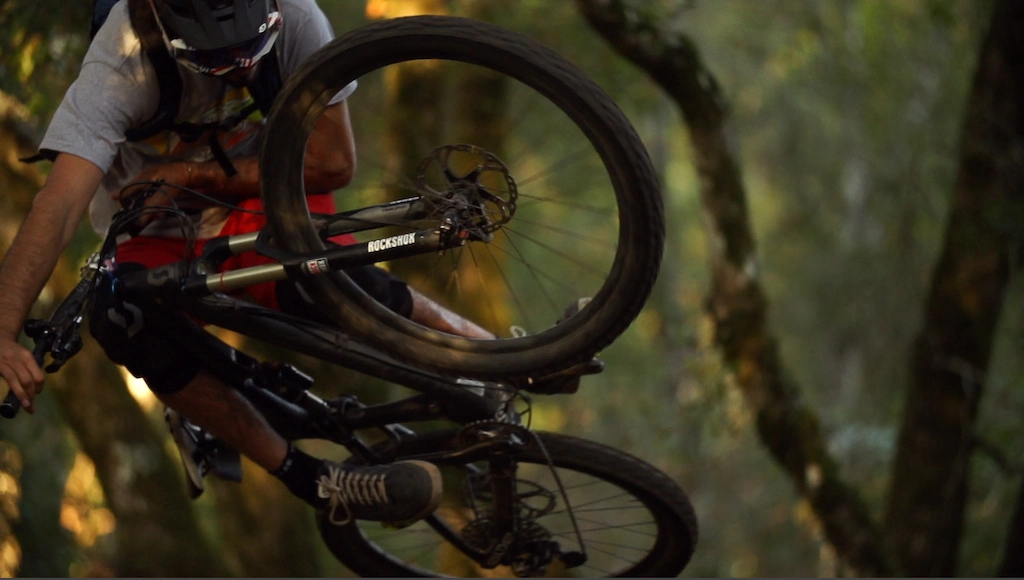
MTB suspension tuning and jumping
Jumping isn’t just for adrenaline junkies – it’s a fundamental skill that every mountain biker can and should learn. And it’s not that difficult once you’ve got the hang of the techniques involved. Also mountain bike suspension tuning can help you to jump better and safer. First we want to give an introduction to how to actually jump with a mtb and then we want to dive deeper into mtb suspension tuning and the effect of jumping.
Step-by-step guide to jumping
Jumping is all about exerting pressure and your ability to control the timing of this pressure through each wheel. First you need to make sure your pumping is up to scratch. Being able to generate speed without pedaling, by snapping your arms, legs and feet from bent to straight, is crucial to understanding how a bike gets airborne.
The take-off
Find a jump that you’re comfortable with, roll in at a comfortable speed, out of the saddle. Keep your weight central, over both wheels, and lower your chest. Start to compress, and feel the force of the lip against your tyres.
Treat each wheel as separate – deal with the front then the back – not both together. Slowly start to transfer your weight from your hands to your feet – the idea is that by the time the front wheel reaches the lip, there’s no weight pushing through it.
Pressing down and then releasing your weight through each wheel when jumping is the same as when you bunnyhop. In this case, the lip of a jump will provide all the lift your wheel will need to follow the trajectory of the jump. This means that jumping is a less explosive movement than a bunnyhop – the idea is to keep your head and core following a smooth arc by using your elbows, knees and ankles to do the pushing.
Weight transfer timings and mtb suspension tuning
The point at which you transfer your weight from your hands to your feet is very important. Imagine a line just past halfway up the lip of the jump – this is the point at which you need to change from pushing with your arms to pushing fully from your feet.
If you’re still pushing into the lip through your arms when you get to this line, you’ll end up getting bucked forwards and over the bars. As the jumps get bigger or your bike’s suspension increases – this line moves further back. Also mtb suspension tuning can affect the timing. Especially the rebound of your shock as well as fork is critical.
The landing
Once you’re in the air, you can relax – the hardest part is done. Spot your landing and use your arms and legs to absorb the impact.
Try to land both wheels at the same time. Touching down the rear wheel first can cause the front to wash out, and steep front wheel landings could end up with you going over the bars.
Then all you need to worry about on landing is staying off the brakes.
Additional jumping technique tips
If you’re struggling to jump using SPD pedals, try fitting some flats.
Start by learning on a tabletop jump, rather than a double, because you’ll have a flat, safe area to land on if you mess up. Don’t go too big too soon.
MTB suspension tuning and jumping
Not only does your technique influence your abilities to jump with a mountain bike but also the chassis settings of your mountain bike. MTB suspension tuning can improve your feeling in the air and you feel more safe and stable.
One of the most dangerous effects of your suspension to your jumping is when your bike tilts forward when jumping. This can be caused by various mistakes in your mtb suspension tuning.
Here is a list:
🚩 Your bike tilts forward when jumping
The Air pressure of your fork is too soft and much softer than your shock’s air pressure
The rebound of your shock is too fast
🚩 Also your bike can jump again when you have hard landings
Rebound on shock can be too fast
Rebound of your fork can be too fast
🚩 Or also your front can go up
The High Speed Rebound of your shock is too slow
The High Speed Compression of your shock is too soft
So I hope this guide helps you to improve your jumping. Not only your jumping technique but also your mtb suspension tuning in regard to jumping. Do not forget to check out our mobile app SAGLY, which helps you to find your ideal suspension settings.
Download SAGLY, a complete mobile guide for your mountain bike riding, suspension settings and maintenance.

